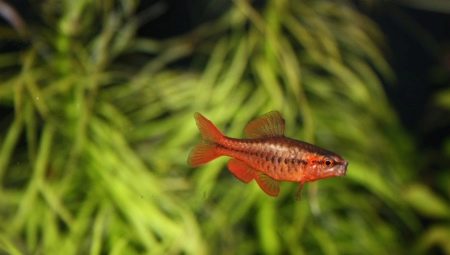Cherry barbus or puntius is a decorative aquarium fish, part of the cyprinid family, is modest in size and has a peace-loving character. These small bright pets feel best in a pack of 6-8 individuals and generally have good compatibility with other fish. Breeding them at home in the aquarium is also not difficult, but you need to remember that for spawning, the female needs special conditions.
The maintenance of a cherry veil barbus and the care of it are not difficult - it is enough to provide space for swimming, plant plants and arrange scenery. Such a pet, including those with ordinary fins without decorative features, is well suited for beginner aquarists. Making a mistake, somehow harming the fish is quite difficult. She tolerates a temporary decrease in temperature, can eat ready-made feed. The only thing that will have to be paid special attention is the purity of the aquatic environment.
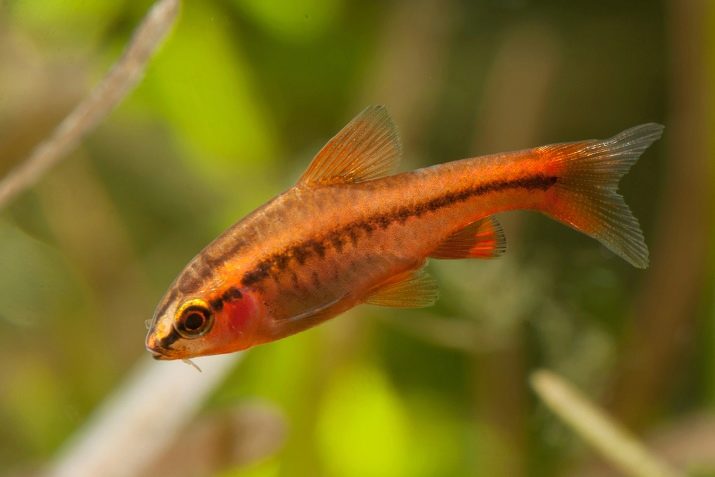
Description
Veil or cherry barbus is a compact fish that naturally lives in Sri Lanka, in the valleys of small shallow rivers. The natural environment of this type of puntius is silty, rich in plants, with warm water. The owner will have to create similar conditions in the aquarium, providing the fish with opportunities for hide and seek and active swimming.
The miniature size - from 2.5 to 5 cm - allows you to make rather modest requirements for choosing a place of residence for a cherry barbus. It easily adapts even to a small home aquarium, you only have to install the lid - the fish are quite jumping, they can easily leave the tank.

A distinctive feature of the cherry barbus is the presence of a bright color in males, it becomes especially intense during the spawning period.
It is characteristic that the fish in nature have an even more saturated color, and their aquarium counterparts are noticeably paler. Females look especially faded, but this factor noticeably facilitates the selection of pets by gender. In captivity, the brightness of the color also largely depends on the quality of nutrition, the regularity of replacement of young animals.
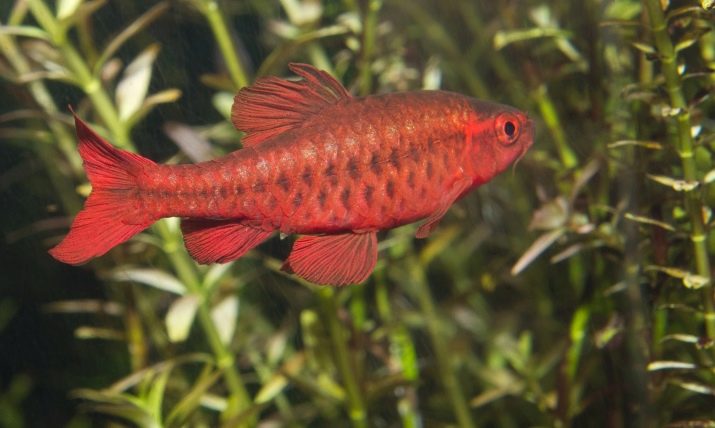
The body shape of the cherry barbus is characteristic of all fish of this species and resembles a torpedo. The fins are small, translucent, the tail is bifurcated, on the body there is a horizontal non-continuous strip running from the nose, and a small mustache on the muzzle. The veil variety has elongated, effectively flapping fins.
Puntius cherry color is hardly a long-liver. The average age of the fish is from 3 to 4 years, under good conditions, it is possible to increase these indicators by another 1-2 years.
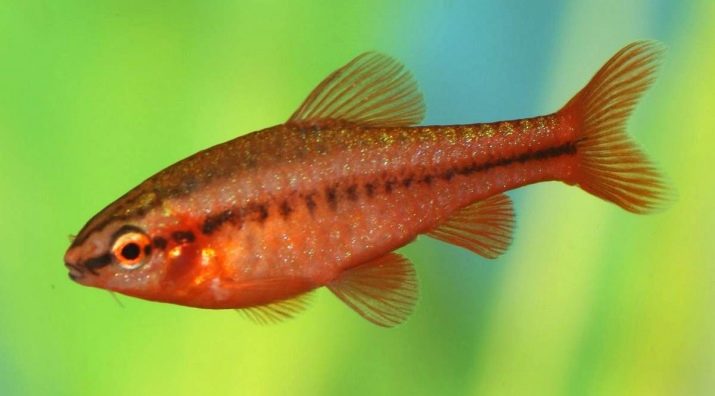
Compatibility
Cherry Puntiuses are extremely peaceful creatures, get along well with almost all aquarium inhabitants. With species content, it is permissible to place up to 10 individuals in an aquarium of 50 liters. Only the neighborhood with cichlids, including peaceful ones, such as scalars, apistograms, is considered dangerous if, when the hunting instinct is awakened, compact fish will be threatened.
Do not plant cherry barbs in the aquarium to the predators - they are almost 100% likely to destroy the entire population.
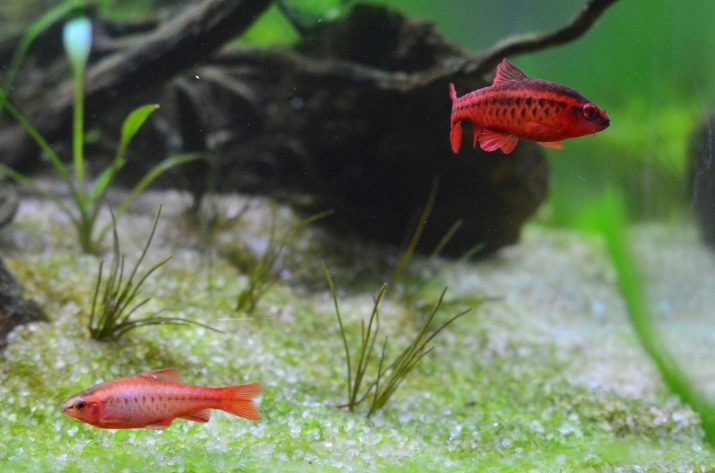
But there are neighbors with whom Puntius gets along well.
- Various types of small crustaceans, including tender shrimp. Their cherry barbus does not touch.
- Representatives of the haracin fish family. It includes neon, tetra, thorns.
- Labyrinth - Lilyus, gourami.
- Pecilian fish. These include guppies, pecilia, swordsmen.
- Small representatives of the carp family. This includes a fiery barbus and a golden one, zebrafish, parsing.
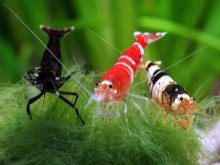
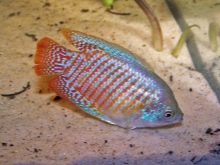
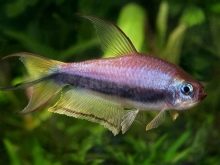
It is very important to select fish for the aquarium with approximately the same level of aggressiveness and size.
This will reduce the possible level of stress, will provide every inhabitant of the underwater world with suitable living conditions.
Growing conditions
Creating comfortable conditions in the aquarium will be easier if the breeder takes into account the individual characteristics of the breed. Cherry barbs in a home environment need careful care and at least 10 liters of volume per individual. A tank of 50 liters is enough to shelter a flock of 5 fish. The shape of the tank is better to choose the classic one in the form of a parallelepiped.
A low and long aquarium without high walls is a good solution to provide the barbs with the necessary space for swimming. Inside there should be enough vegetation and scenery, you can equip the mainsail or place large snags at the bottom. Water must be maintained in good condition, regular pollution control is required. Depending on the presence of other inhabitants, it may be necessary to change from 1/3 to 1/5 of the liquid volume weekly.
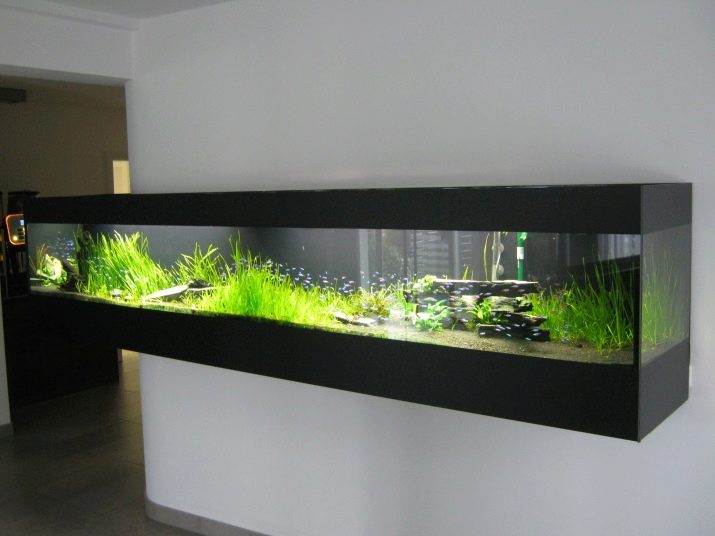
For tap water, even tap water is suitable, but it must be clean, filtered, pass through sedimentation.
Optimum temperature parameters + 22 ... 27 degrees Celsius, You can refuse to heat if the room is warm. It is necessary to maintain a pH level in the region of 6.3-7.6, the optimum hardness of 6-18 dH.
Caring for a cherry barbus in a home aquarium is also easy. He needs regular feeding, and also it is necessary to control the health status of pets. To reduce the stress of external factors, it is recommended to use daylight and additional illumination with lamps, dark loose soil, emphasizing the brightness of the color of the fish. You can use volcanic sand or dark gravel.
When choosing vegetation for an aquarium, you should not save on the amount of greenery.
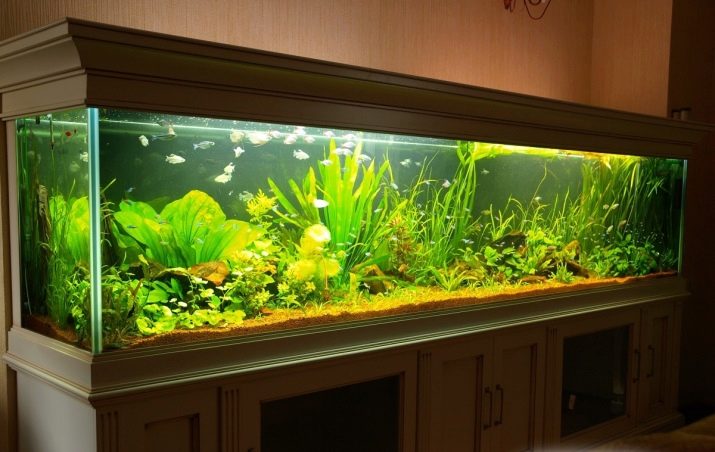
In the natural environment, cherry barbs live almost in thickets, in coastal factories, and they will feel anxious in a bare pond.
Ambulia, Caroline bacopa, Vallisneria, Hygrophil, Aponogeton are best suited for these fish.
In order for the closed ecosystem of the aquarium to function successfully, it is necessary to equip it with the necessary equipment. Necessarily needed in the tank filter, aerator. Additionally, a pump can be installed to help maintain a cleaner environment that simplifies the circulation of water.
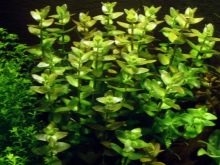
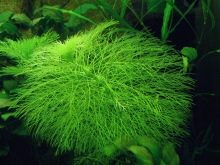
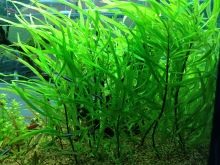
Proper feeding
The optimal diet of cherry barbs is one that is close to natural. It should have quite a lot of protein, live food. But in general, these aquarium fish are quite omnivorous, eating dry food - flakes, granules. The proportion of dry food will be 25-30%, of the plant additives are most useful leaves of dandelion, nettle, spinach, lettuce.
Due to the tendency of fish to overeat, it is necessary to periodically arrange at least once a week fasting days without feeding. The rest of the time, two feedings per day will be sufficient. The compact size of the puntius, small mouth do not allow them to immediately capture a large amount of food. The feed is crushed, or products with the smallest fraction sizes are selected. Vegetables and leaves are poured with boiling water to destroy the bacterial flora.
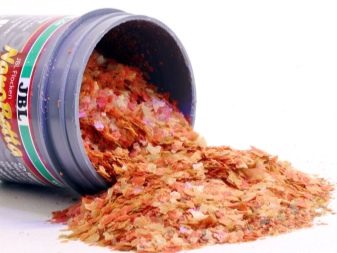
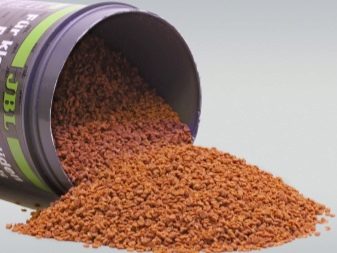
Of animal food, you should definitely choose artemia, tubule, bloodworm, grinding them carefully beforehand.
Ready-made feeds can be offered, especially those that enhance the brightness of the color of the fish. It will be useful to include green peas, chopped cucumber or zucchini in the diet. It will also be useful to use fish frozen foods. It is first thawed, and only after that they are given to the pets.
After feeding, food debris must be removed from the tank, keeping the water clean. If this condition is not fulfilled, the medium will turn sour, toxic compounds are formed in the aquarium that are deadly for fish. The optimal serving size is the one that is eaten in 5-7 minutes. Obesity is extremely harmful to barbs, can cause them to die.
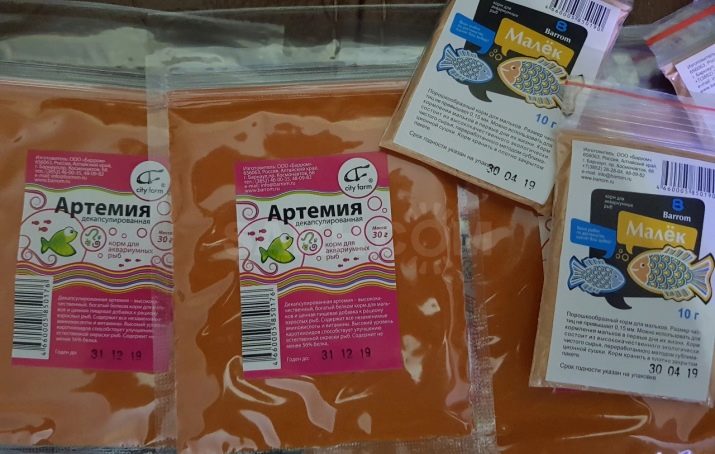
Sexual differences and reproduction
The gender difference in cherry barbs is quite bright and clear, especially during the period of approaching spawning. The males at that time acquire that rich coloration, for which the species got its name. In females, in preparation for spawning, the volume of the abdomen increases significantly. When letting individuals breed, it is recommended that they be transplanted into spawning grounds so that other fish do not destroy the clutch.
The fish demonstrates its readiness for breeding as early as 9-12 months.
When keeping, it is recommended to plant at least two males per female. Spawning can be caused by increasing the temperature in the spawning tank by 1-2 degrees, to provide enhanced nutrition with animal feed. The bottom of the spawning aquarium is lined with a special mesh, plants, Javanese moss should be placed on top. At the end of spawning, adults are planted out of the aquarium, the net is removed. Egg fry appear after 2-3 days.
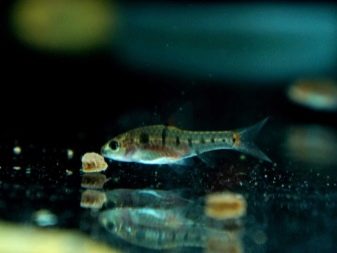
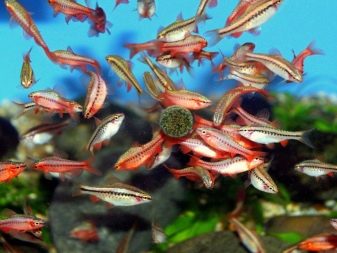
Possible content issues
Consider what problems a cherry barbus can deliver to the owner in content. In the first place, the atypical behavior of the fish may become a cause for alarm. If she twitches when swimming, moves unevenly, or looks too sluggish, the cause should be sought as quickly as possible.
Among the most obvious problems are stress and adverse conditions.
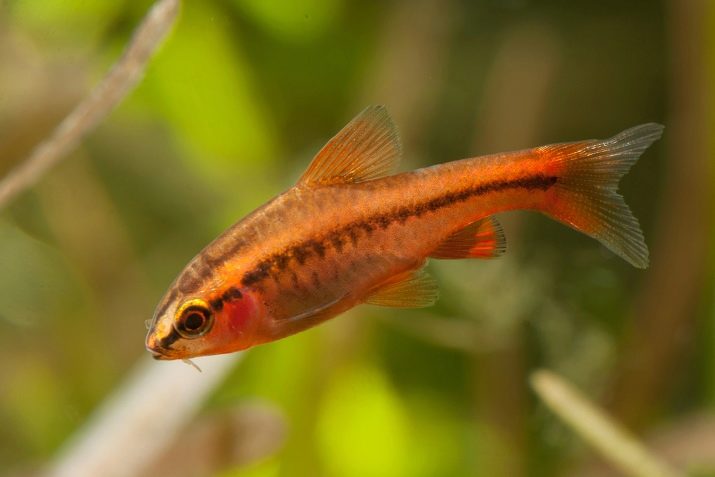
Manifestations of nervousness are usually observed with:
- too high population density of the aquarium;
- the presence of aggressive neighbors;
- solitary confinement;
- insufficient number of plants.
Cherry barbs need a company of their own kind, moreover, left without a fellow tribesman, they can get sick, show reduced physical activity.
An overly bright illumination in a poor greenery reservoir can also become a cause of nervous jerking. If there is not enough shelter, the fish can be very stressed.
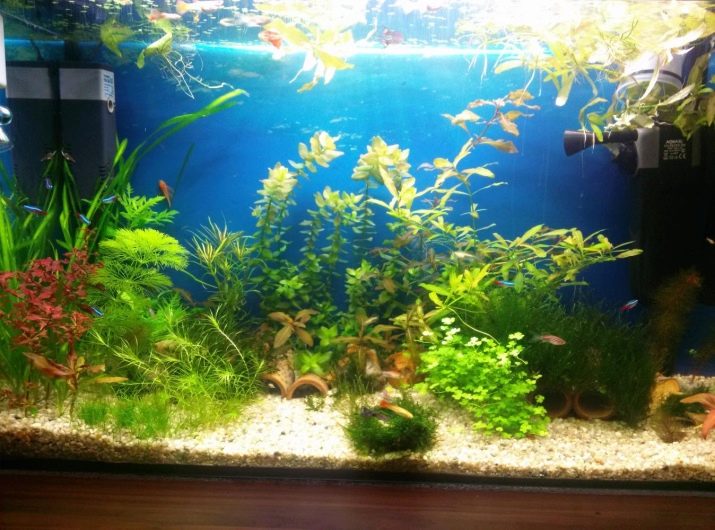
When buying cherry barbs, many aquarists are disappointed in their color. Fish remain faded, do not gain brightness. You can fix the problem only with good conditions, abundant and varied nutrition, and the absence of stress factors. It is important to remember that females of this species of puntius are initially less colored. Special feed lines help stimulate the development and color saturation of males.
Barbs are sensitive to the presence of nitrogen and ammonia, to water hardness. If the pet clearly reduces its level of activity, becomes sluggish, it is worthwhile to conduct drop tests of the environment in which it is contained.
Do not neglect the rules of care - water change should occur weekly at least in the amount of 1/5 of the total amount of liquid.
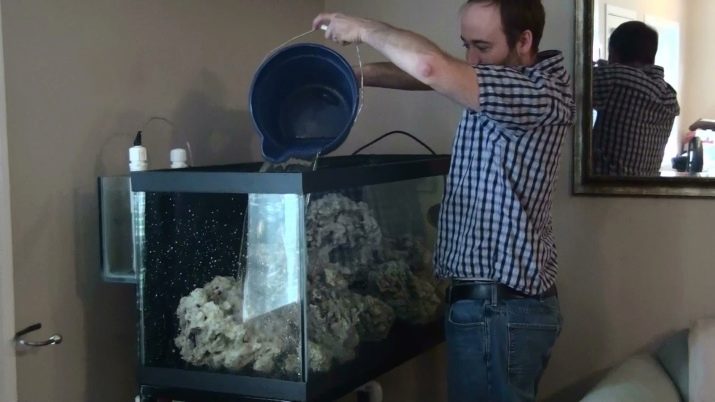
Eating plants is the norm for cherry barbs. This behavior does not indicate poor feeding. Just in nature, fish does the same. For eating, it should cost to plant small-leaved plants, and with the help of specimens with large foliage create the necessary shadow.
For more serious health problems, it is worthwhile to more carefully study the conditions created for the life of a cherry barbus. If necessary, fish can be isolated and quarantined.
See how to spawn from the cherry barbus.
